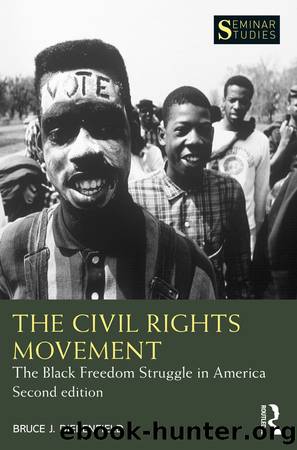The Civil Rights Movement by Bruce J. Dierenfield;

Author:Bruce J. Dierenfield;
Language: eng
Format: epub
Publisher: Taylor & Francis (Unlimited)
Published: 2021-03-15T00:00:00+00:00
10âLet freedom ring
To compel President John Kennedy to do something about the âsnail-like pace of desegregation in the South,â Martin Luther King embraced what he called the movementâs âgreatest weaponââmass demonstration. The idea of a huge rally in Washington to push for federal government help had first surfaced when Coxeyâs âarmyâ protested widespread unemployment in the 1890s. During World War II, the idea was advanced by A. Philip Randolph, a black socialist, and King contacted the movementâs âgrand old manâ to see if all parties could work together to claim their rights. Randolph was glad to cooperate, though his focus was different. Black unemployment, he noted, was more than twice the rate for whites, and a typical black family earned about half what an average white family did. Compounding these economic problems was the systematic disfranchisement of many blacks, making democracy a cruel hoax to them. Working with Bayard Rustin, the movementâs best organizer, Randolph suggested that a national gesture for economic reform could prod politicians to double the minimum wage and create a large federal jobs program. In the spring of 1962, Randolph proposed two days of lobbying and sit-ins at Capitol Hill and ending with a large rally at the Lincoln Memorial. By transforming the civil rights struggle from a regional to a national campaign, the massive demonstration for equal rights and economic equality would be the movementâs high-water mark and the greatest demonstration for freedom in American history.
Other civil rights leaders had reservations about the plan. The NAACPâs Roy Wilkins opposed a march as too expensive and too ineffectual in influencing legislation. Wilkins had reluctantly supported the formation of three modest rallies in Washington for voting rights and school desegregation in the late 1950s, but believed they had produced no concrete results. Randolph intimated that any new march would be tainted by Rustinâs homosexuality, former membership in the Young Communist League, and imprisonment for resisting the draft for the Korean War. Wilkins overlooked Rustinâs international organizing experience and his contributions to CORE and SCLC. The Urban Leagueâs Whitney Young Jr. worried that his organizationâs tax-exempt status would be jeopardized by backing a political event. For John Lewis, chairman of the comparatively radical SNCC, a march was just the beginning. To challenge a foot-dragging government, he proposed paralyzing Washington with camp-ins on the White House lawn, lie-ins across airport runways, and sit-ins in Congress and the Justice Department.
These reservations from competing civil rights groups forced a compromise, as did the sheer size of the event, the necessity to cooperate with government officials, and the implementation of a mass marketing campaign. All major civil rights leaders, including Wilkins, signed on, provided the purpose be changed to âjobs and freedomâ and Randolph be named the marchâs director. Randolph accepted the draft and promptly named Rustin deputy director. For the first time, all major civil rights leaders and organizations set aside their squabbling to collaborate on a national undertaking for racial justice. But the economic goals Randolph long favored took second
Download
This site does not store any files on its server. We only index and link to content provided by other sites. Please contact the content providers to delete copyright contents if any and email us, we'll remove relevant links or contents immediately.
The European History Highway: A Guide to Internet Resources by Dennis A. Trinkle Scott A. Merriman(498)
The Seven Wonders of the Ancient World by Michael Denis Higgins(479)
European Security in a Global Context by Thierry Tardy(472)
European Security without the Soviet Union by Stuart Croft Phil Williams(472)
The Routledge companion to Christian ethics by D. Stephen Long Rebekah L. Miles(460)
Hudud Al-'Alam 'The Regions of the World' - a Persian Geography 372 A.H. (982 AD) by V. V. Minorsky & C. E. Bosworth(402)
Gorbachev And His Generals by William C. Green(393)
Get Real with Storytime by Julie Dietzel-Glair & Marianne Crandall Follis(391)
Tibetan Studies in Comparative Perspective by Chih-yu Shih Yu-Wen Chen(387)
Governance, Growth and Global Leadership by Espen Moe(385)
Hyperculture by Byung-Chul Han(379)
CliffsNotes on Fitzgerald's The Great Gatsby by Kate Maurer(362)
The Oxford History of the World by Fernández-Armesto Felipe;(356)
How Languages Are Learned 5th Edition by Patsy M Lightbown;Nina Spada; & Nina Spada(354)
The Egyptian Economy, 1952-2000 by Khalid Ikram(354)
Oral Poetry and Narratives from Central Arabia: The Poetry of Ad-Dindan : A Bedouin Bard in Southern Najd (Studies in Arabic Literature, Vol 17) (English and Arabic Edition) by P. M. Kupershoek P. Marcel Kurpershoek(345)
The Oxford Handbook of the Incas by Sonia Alconini(336)
Europe Contested by Harold James(322)
The Hutchinson Dictionary of Ancient and Medieval Warfare by Peter Connolly John Gillingham John Lazenby(307)
